NAGABANA - The Guardian of Ecosystem
13 Jan 2023 18:26:09
I have heard many times that our ancestors have kept everything ready, whatever the things needed for our peaceful life and to be inculcated in our lifestyle. I was wondering ‘How?’ When I started to learn about Nagabana , I realised the truth. Till then I used to visit Nagabana only during the occasion of `Nagarapanchami’. When the Science & Technology Department of the Central government organized National Children’s Science Congress- 2022-23 and chose ‘Understanding Ecosystem for Health and Well-Being’ as the Focal Theme, I made up my mind to study Nagabana along with my classmate Gourav Kumar P.
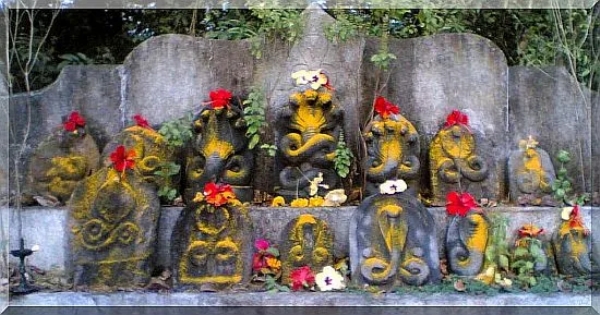
The study of ecosystems shows different paths that people have followed for nature worship. ‘Sacred Grooves’ are the most prominent areas where we can easily identify the ecosystem services. If we understand a sacred groove, then understanding ecosystem services is much easier. To describe easily, Sacred grooves are the uninterrupted or undamaged patches of vegetation situated in the villages or sometimes rarely in the towns. These mini forest areas are dedicated to local folk deities. They have a special religious importance within a particular culture and are protected by a specific community of people of that area.
By providing living spaces for different types of plants and animals, Sacred grooves act like a repository for biodiversity. Devarakadu, Devarabana, Bhuthadabana in Karnataka, Kovilkadu in Tamilnadu, Kavu in Kerala, Lai Umang in Manipur, Devrai in Maharashtra, Dev Van in Himachal Pradesh are the sacred grooves regarded as the treasure houses of biodiversity. Likewise, in Coastal Karnataka, including Udupi and Mangaluru, Nagabana is a sacred groove, a place of nature worship.
In Udupi and Dakshina Kannada districts, people are very much familiar with Nagabana. When I came to know about these sacred grooves, I became more curious. Why have our ancestors given such an importance to the sacred grooves? Why were the sacred grooves inculcated in our culture and tradition? To find the answer, I thought, my choice of study of Nagabana is the right decision.
In the beginning, we visited several Nagabanas situated mainly in Udupi and Mangaluru Districts. However, we selected the Nagabana situated at Nandikooru village of Udupi District and the Kandabari Nagabana situated at Kuthpady village of Udupi District as our study area. Nandikooru Nagabana is not concretized and still in its pure form. Usually, Nagabanas vary in size from 3 cents to 3 acres. The Nandikoor Nagabana occupies an area of 25 cents (10,889 square feet) and the Kandabari Nagabana occupies an area of 5 cents (2178 square feet).
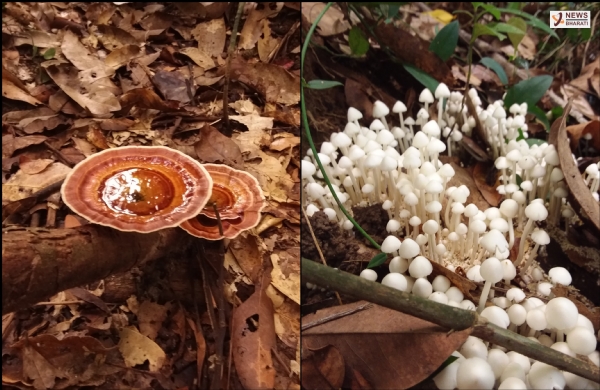
As we are still studying in 10th standard, for the study we have been guided by Dr. Nandini Shetty, who has conducted research on female Asian Elephants in the Jawaharlal Nehru Centre for Advanced Scientific Research, Jakkur, Bengaluru. As per her direction we have identified flora and fauna of both the Nagabanas along with Carbon Estimation, interviews of the owners/caretakers of Nagabana, Survey using questionnaires to understand the opinion of people about Nagabana and creating awareness among the public and students. The owner of Nandikoor Nagabana Mr. Ramesh Bhat Adve and Mrs. Shobha and Mrs. Girija of Kandabari Nagabana have wholeheartedly extended their helping hand for our study. As the localities identify the plants and trees with their local names, sometimes it was difficult for us to identify their botanical names. Hence, Mr. Uday Kumar Shetty, Medicinal Supervisor, Pilikula Developmental Authority, Mangalore has helped us in identification of plants.
In Kandabari Nagabana there are more than 100 trees and in Nandikooru Nagabana there are more than 700 trees. In our study we have identified- Karmara, Jarige, Bogimara, Gandhagarige, Mango, Daaruharidra, Kedage, Chandana, Renje, Jackfruit, Hebbalasu, Kuntala, There Mara, Bandakayi, Otehuli, Nerale, Andipunar, Parontolige, Gulaganji, Manjutti, Churimullu, Acharibooru, Urkiballi, Jangamasoppu etc,. around 36 plants and trees, Eshwaraberu, Shathavari, Sarpagandha, Kepula, Ollekodi, Karande etc., around 6 medicinal plants, with the help of local people Kingfisher, Drongo, Hornbill, Parakeet, Jungle Fowl, Owl, Civet etc., around 29 types of birds and animals. We were in amazement when we realized that these two small patches of forests are home for the vast biodiversity.
Treasure house of biodiversity
Nagabanas are maintained by indigenous people and are the ancestral properties inherited by them. In Coastal Karnataka, since ancient times, the agriculturist families have dedicated some area of their agriculture property to the Nagabanas and the subsequent generations have protected these Nagabanas as sacred grooves. As Sacred Grooves are dedicated to local folk deities, Nagabanas are dedicated to ‘Naga’ – the ‘Serpent God’.
Nagabanas serve as a repository for biodiversity. They are home to many medicinal plants, endemic trees, birds, animals, rich soil, and unpolluted air. This indicate that they contain complex food webs. They provide various ecosystem services like food and shelter to many organisms, replenishing groundwater tables, recycling of nutrients etc. Hence, they are crucial to the environment.
Lichens are the keystone species in many ecosystems. They serve as a food source and habitat for many animals such as birds, rodents etc. Lichens are extremely sensitive to air pollution. Hence, their absence indicates how much an area is polluted. In Nagabanas they are found in abundance. This indicates that Nagabanas are unpolluted and rich in oxygen.
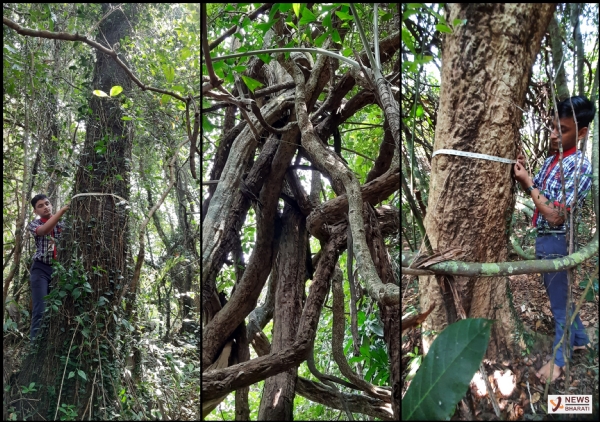
Nagabanas are the best example for ‘In-Situ’ conservation. In-Situ conservation means the conservation of a species in its natural habitat and the maintenance and recovery of a viable population of species in their original place. As Nagabana is regarded as sacred, tree cutting, hunting and any other type of developmental activities are prohibited. Agriculture activities and cattle grazing inside Nagabana is also prohibited. Only once in a year, i.e. during Aashada Amavasye (new moon day) they perform the cleaning of Nagabana, that too, only the area where pooja is performed. Rest of the year Nagabana remains untouched. Due to the unique management by the owners, the Nagabanas remain pristine and hence, the conservation of species in its natural habitat can be possible. As the area remained untouched for hundreds of years and the quality of the soil bed is very rich in organic matter. The presence of earthworms in the soil of Nagabana supports this view. As we know, the earthworms are the bio indicators of soil quality.
Large Carbon Sink
People might say, `the concept of forest and In-Situ conservation is helpful for the dependent animals and birds. What benefits can we humans get from the forests?’ Plants and trees absorb atmospheric Carbon dioxide, convert it into Carbon and store it in their trunk. Through this process we get Oxygen for us to breathe. Hence the plants and trees are the Carbon Sinks of our ecosystem.
We all know, global warming is caused by Greenhouse gases that are released to the environment and Carbon dioxide is the most commonly produced Greenhouse gas. By deforestation, industrialization, air pollution etc., Carbon dioxide is released to the environment continuously and will increase its adverse effect on global warming. In recent years, this has become very serious problem and to cope up with this, the UNO (United Nations Organization) has declared 2021-2030 as the UN Decade on ‘Ecosystem Restoration’ within structures and available resources and has mentioned that the healthier our ecosystems are, the healthier the planet and its people. The UN Decade aims to prevent, halt, and reverse the degradation of ecosystems on every continent and in every ocean. And has expressed that the aim will only succeed if everyone plays a part.
What does this mean? In the 2015 Paris Agreement and in 2019 United Nations Climate Action Summit in New York, more than 75 countries including India have committed to cut their greenhouse gas emissions to net zero by 2050. Net Zero refers to the removal of Greenhouse gases that are released to the environment. The term Net Zero is important because this is the state at which global warming stops. To reach this Net Zero status, different countries have different plans, as India has planned for the integration of new mangrove forests at Sundarbans, West Bengal. But Nagabanas are already serving the nation to reduce atmospheric carbon.
The foresightedness of our ancestors is appreciable. Nagabanas have been in our tradition for thousands of years and since then they are rendering service as Carbon Sinks without any financial support.
Vanishing belief
Though both the Nagabanas have hundreds of trees, we have estimated carbon stock of only 58 trees and the result we found is 31 Tons of carbon stock. This result is only for a few trees. Imagine the contribution of all the trees of the whole Nagabana and the contribution of all the existing Nagabanas in the society. Not only that, what will be the contribution of any National Park forest?
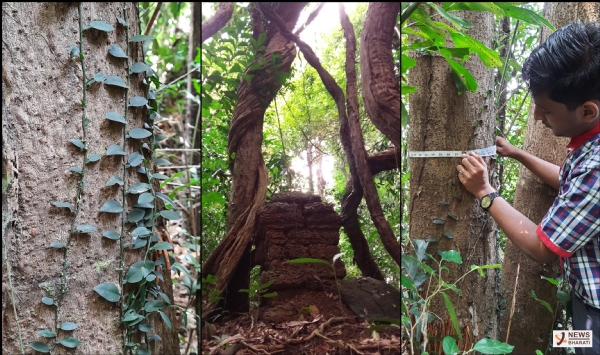
The recent demands of industrialization, urbanization, deforestation, and infrastructure development are posing great threats to Nagabana. As the young generation of farmers are losing belief in their inherited culture, many of the Nagabanas are reducing in size because of agriculture, road expansion etc. This may result in the depletion of flora and faunal diversity. Nowadays, the young generation is migrating towards the cities. Hence, the Nagabanas have lost the caretakers and have been reduced to a small concrete structure. The attached patches of vegetation have disappeared in many places. The mammals, birds and animals which were previously inmates of the Nagabana have become homeless. This has also led to loss of many endemic trees. In many of the Nagabanas only the pooja is performed and the inherited age-old true purpose of ‘In-Situ Conservation’ is vanished.
What are the reasons for this depletion? To know the opinion of the people we conducted one survey. Through which we got to know, 73% of people knew about Nagabana and its attached forested land and it needs to be protected. But 15% of the people, though they knew about Nagabana, did not have any clear opinion about the forested land of Nagabana. And, 12% of people said only concrete structure is enough for Nagabana. They feel as it would not generate economic benefit, allotting land for Nagabana is a waste.
Only when we have the knowledge of forest, will we stand for them. As an effect of global warming, the sea level is rising, coral reefs are dying, and the world is witnessing floods, cloud bursts, cyclones and drought regularly. Human activities release more carbon into the atmosphere than the earth’s natural carbon sinks can absorb. Hence, for tackling climate change and to keep our climate stable, protecting existing carbon sinks or creating new carbon sinks is very much essential. Now we can understand why UNO has declared 2021-2030 as the UN Decade on ‘Ecosystem Restoration’.
Service in Silence
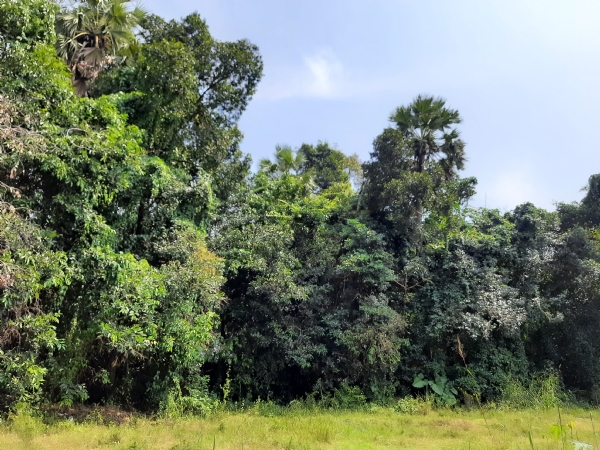
Due to the destructive impact of climate change through the heat waves, the world is in great expectation of remarkable solutions. Through afforestation, we can grow trees and trees serve as carbon reservoirs like the Nagabana. This will help India to become a net zero nation. However, an ‘In-Situ’ conserved forest patch is a boon to the ecosystem as they do not need much financial support.
Our ancestors were very wise and generous and have allotted a portion of their land to Nagabanas, very contrary to the present scenario of the real estate business. Our ancestors were benevolent and have offered their service to nature whole heartedly. Though we witness deforestation and concretization of Nagabanas, many of the present day Nagabana owners (basically agriculturists) are strictly following their ancestors’ path even when they know that they do not have any economical support from these Nagabanas. Hence, their nobility has to be appreciated. We, being the educated citizens of India must motivate them to continue their service in the future also.
Nagabanas have been playing their part for centuries for the noble cause without any request. Their vital role in healing our planet is priceless. Being an ‘In-Situ’ conserved forest area, Nagabanas have become the life support system of our planet. And, in their true sense they are the true guardians of our ecosystem. They are serving our nation silently to reach its global target of Net Zero by 2050. Hence, we, human beings, should understand our responsibility and should become a part of worlds’ call for healing our planet. Let us strengthen our guardians of the ecosystem by joining our hands to the conservation of Nagabanas.
- Avanikrishna Adve
